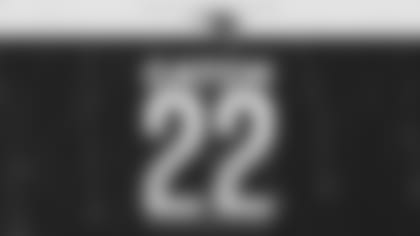New England is riding high following a game that we haven't seen them win during the Mac Jones era in Foxborough: no asterisk, no backup quarterbacks, no weather-impacted results – a straight-up victory.
During the post-Brady years, the Patriots are 4-14 in games where their opponent would eventually make the playoffs that season, and, with Jones, they're a disappointing 3-9. In those three wins with Mac as QB1, the Patriots beat Dolphins backups Teddy Bridgewater and Skylar Thompson (Week 17, 2022), Buffalo in a bomb cyclone (Week 13, 2021), and a Titans team that was ravaged by injuries in Week 12 of Jones's rookie season (no Derrick Henry or A.J. Brown).
Fair or not, there was always an asterisk next to any win over a quality opponent in recent seasons. Plus, the Pats won while coming from behind in the fourth quarter and with Jones orchestrating his first-ever game-winning touchdown drive. It was a monkey off their back win for New England, but that isn't our biggest takeaway as we spin it forward.
Heading into the matchup with the Bills, we posed a simple question in this space last week: do the Patriots have the buy-in to turn their season around? Make no mistake about it: buy-in, pushback, fight, or however you want to put it was in doubt at 1-5. Without a competitive spirit, the X's and O's wouldn't make a difference; you have to believe you can win.
Well, it appears that the players haven't tuned out their head coach, who remains on a warm seat after the franchise's worst start since 1995, and now they might have a little more confidence in their quarterback. It's possible that the Patriots got up to play the Bills at home and will now have a crash landing in a house of horrors for this franchise going back decades. But the sense we get is that this team wants to go down swinging this season rather than rolling over because they dug themselves into a hole that is typically insurmountable.
Now that we've hopefully determined that this team has the competitive drive to make something of their season, the Patriots have to accomplish another first: beat Dolphins quarterback Tua Tagovailoa. Tua is a perfect 5-0 vs. the Pats, including a 24-17 victory at Gillette Stadium earlier this season, which is the best record of any quarterback against Belichick. Now, the Dolphins offense might be down multiple starters, including star WR Tyreek Hill (hip, status unknown), RB Raheem Mostert (ankle, status unknown), starting LT Terron Armstead (IR), RB De'Von Achane (IR), and LG Isaiah Wynn (IR). But Tua was 3-0 against the Pats before Hill and head coach Mike McDaniel's arrival.
Although his numbers against the Patriots defense aren't eye-popping, Tagovailoa has been a thorn in Belichick's side and is now piloting a historically great Dolphins offense to a 5-2 record. The Dolphins 240 points through seven games are the most by any offense since the 2015 Patriots, and their 3,236 total yards are the most in the last six seasons. At one point, Miami was on a record-setting pace in total offense, but they have cooled off a bit in recent weeks.
The Patriots unique defensive game plan that featured three deep safeties, at least to start, kept the top on the defense to hold the Dolphins high-powered offense to 24 points and 389 total yards, their second-lowest yardage output this season, so there were some good things.
However, that doesn't necessarily tell the whole story about that Sunday night. The Dolphins offense moved the ball with relative ease, adding +0.19 expected points added (83rd percentile) with a 53% play success rate (92nd percentile), opening a 17-3 lead and holding a two-score lead throughout the game until the Patriots offense woke up in the fourth quarter.
The Patriots offense might be better equipped to win a game in the mid-to-high 20s now. But the Pats need a better start defensively than back-to-back scoring that were 13 and 11 plays amassing over 70 yards each. Ultimately, Miami efficiently marched down the field several times on New England's defense, so you'd expect a slightly different approach this time.
As they make the trip to South Beach for round two against the Dolphins, here are our keys to victory and key matchups for the Patriots to get a win in Miami on Sunday:
Defensive Key - Disrupt the Timing of Miami's Passing Game, Stop the Run Out of Light Boxes
Before we get into why the Patriots game plan defensively didn't work in September, let's go over the things that were successful against the Dolphins offense in Week 2, while also understanding that Miami's injuries present an unknown factor.
Still, with Tua under center, you would think that McDaniel would still run his offense with whatever personnel the Dolphins have out there, so it doesn't change much about the game plan. Tagovailoa said after the first game, "[It] seemed as if they wanted to put an umbrella over our two fast guys. As the game progressed, they started to get back into what they normally would run."
New England had some good coverage reps out of the three-deep safety looks at first. For example, one of the Dolphins staple plays is running Hill and speedy running mate Jaylen Waddle on in-breaking routes off play-action. This season, only Brock Purdy and Jared Goff have thrown more in-breaking routes than Tua (41%). Miami loves throwing slants, skinny posts, and crossers, so the Pats took those away.
Here, the Patriots start with three safeties across the deep part of the field, with five defenders in the backend, giving tons of cushion to the Dolphins two wideouts. After the snap, the Pats rotate from the three-deep structure to a cover-three zone, with the two "buzz" defenders rotating down into the in-breaking passing windows to make Tua hold the ball.
However, McDaniel quickly adjusted after seeing the Patriots rotate three deep safeties into single-high and split-safety shells. The Dolphins coach recognized that the coverage structure left the Patriots vulnerable in the flats, so he used "cheat" motion to expand the flat defenders, creating space for catch-and-run plays into the open areas underneath the umbrella coverage.
Miami might not have hit as many explosive plays as they usually do, with Tua only hitting one 20-plus air-yard throw on four attempts with a deep-ball INT. But Tua was incredibly efficient on throws under ten air yards, finishing the game 17-of-19 while averaging 8.5 yards per attempt. Tagovailoa also recorded a 2.08-second average time to throw, the fourth-quickest release in a game since the 2020 season.
With the Patriots failing to disrupt Miami's receivers because they were playing so much soft zone coverage, inviting the quick throws, Tua was only under pressure on six of his 31 drop-backs (18.8%). The lack of pressure on the quarterback and receiver disruption allowed the Dolphins to control the game on offense, while there were also issues against the run.
Since the game plan was centered around stopping the passing game, the Dolphins ran 21 times into light boxes, averaging 6.1 yards for 129 yards, with Raheem Mostert's 43-yard touchdown being the backbreaker in the fourth quarter. Even without Mostert's long run, the Pats still gave up 4.3 yards per rush in light boxes.
As we look ahead to round two, the Patriots need to be more physical with Dolphins wideouts at the line of scrimmage to disrupt the timing of their routes, making Tua hold the ball longer so the pass rush can impact the game. The Dolphins quarterback is a rhythm-based thrower, where he's deadly when he's throwing on time, so you off to get him off-script. Plus, you have to hold up against the run with fewer defenders in the box.
Last week, the Eagles held the Dolphins to a season-low ten points because they accomplished those two things. First, Philly held Miami to 31 rushing yards on seven carries into light boxes (4.4 average). Some of that success was because the Eagles played 18 snaps in base defense, which the Patriots also did (47.5% base), but weren't as effective stopping the run.
| Tua Tagovailoa | vs. Patriots | vs. Eagles |
|---|---|---|
| Avg. Time to Throw | 2.08 | 2.35 |
| Pressure Rate | 18.8% | 37.1% |
| % of Passes Over 2.5s | 23.3% | 40.6% |
| Pass Avg., Short Throws | 8.5 | 2.9 |
Philly also jammed the Dolphins receivers more at the line, with Tua holding the ball for over 2.5 seconds on 40.6% of his pass attempts. In other words, Philly gave their pass rush a chance to get home. Unlike the Patriots, with more physical coverage, Philadelphia limited the Dolphins passing offense on throws under ten air yards. Philly held the Dolphins to 52 yards on 18 short pass attempts, a 2.9 average compared to 8.5 yards per attempt against New England.
Philadelphia still played primarily zone coverage to keep the top on the defense, but they did it out of split-safety shells with their defensive backs near the line of scrimmage to jam the receivers as they released upfield. Above, Philly is in a traditional spot-drop cover two, but you see their outside corners jam the outside receivers before falling into the flats. With Tua likely reading those corners matching vertical releases, he tries to throw the short stick route, but the corner falls off the outside receiver to make a play on the ball. The corner is free to have zone eyes to jump the underneath route because he has a half-field safety over the top.
Although the Eagles didn't play much man coverage (six snaps), it was mostly a two-man scheme when they did. Cover-two man allows the man coverage defenders to have inside leverage on the receivers to take away those in-breakers we mentioned previously while still having safety help over the top against verticals so they can be more aggressive at the line.
The other neat wrinkle by Eagles DC Sean Desai is that he tilted the deep safeties toward Tyreek Hill. The issue with playing two-man with inside leverage is that Hill can just run a go ball with easy access to an outside release, and Hill is so fast that the half-field safety mid-pointing that side of the field can't get all the way out to the sideline in time.
Desai's game plan wrinkle put the half-field in a better position at the snap to stay over the top of a vertical route by Hill. The Patriots did something similar when they played man coverage in the first matchup, but with only a single-high safety, leaving them vulnerable to one-on-ones on the other side of the formation.
The Eagles coverage plan against the Dolphins allowed their pass rush, with some help via simulated pressures (see first example), to pressure Tua on 37.1% of his drop-backs. As a result, Tagovailoa produced his second-lowest total EPA output this season (-7.1). It's not a coincidence that the Dolphins two worst offensive performances were the two games where Tua was pressured the most (vs. Philly and Buffalo).
With the Dolphins offensive line down multiple starters, the Patriots need to take a page out of the Eagles playbook to allow their resurgent defensive front to impact the game. If there's a weakness in this Miami offense, it's that they can be pushed around up front.
As cliche as it sounds, the Patriots absolutely need to be the more physical team on defense.
Offensive Key - Improve Downfield Passing Game By Stressing Fangio's Base Coverages, Be Better Prepared For Dolphins Front Mechanics/Blitzing
The Patriots offense is coming off a momentum-building win over the Bills, but now it becomes about sustainability as we turn the page to O'Brien vs. Fangio Round II.
Patriots offensive coordinator Bill O'Brien will continue building on the good things the offense did last week. Hopefully, they'll stick with the offensive line combination that worked and skill position groupings that seemed to spark the offense with more speed to stretch out the Bills defense horizontally.
As a split-safety revolutionary, Fangio is the founding father of a defensive system that is taking over the NFL to shut down explosive passing offenses. The challenging aspect of Fangio's scheme is that the pre-snap picture doesn't give much away to the quarterback. The veteran DC's base coverage is cover six, where the defense will play quarters to the passing strength and cover two to the weakside. The challenge for the quarterback is that Fangio will spin the dial into traditional quarters (cover-4), cover three zones, and occasionally cover one (man), which the defense can get to from the same pre-snap safety alignment, making the quarterback read it out post-snap.
In the first matchup between the two veteran coordinators, Fangio got the better of O'Brien and quarterback Mac Jones with a stacked deck. New England went into the game without starting left tackle Trent Brown and was still hoping that free-agent addition Calvin Anderson was the answer at right tackle. Well, spoiler alert: that didn't go well for the Patriots offense.
Anderson and backup tackle Vederian Lowe gave up a combined two sacks and seven quarterback pressures, with Fangio mixing in 15 blitzes, forcing Jones to succumb to short throws against the Dolphins DC's typical zone-heavy coverage system, which stifled the Pats to 5.3 yards per pass attempt against a coverage plan that was very cover three and cover six-heavy (74.4%).

Jones was also sacked four times with a 36.2% pressure rate, making New England's drop-back passing game non-existent. The Pats QB1 didn't complete a single deep pass (0-5), was 6-of-15 on throws over ten yards, and it was the only game this season where the Patriots failed to generate an explosive play (20+ yards). In fact, the Pats longest gain of the game was an 18-yard scramble by Jones.
New England struggled to move the ball against a Dolphins defense that hasn't been great this season. Miami is 24th in defensive DVOA and 27th in scoring defense (26.7 PPG). But against a defense built to stop explosives, it's even tougher if you can't pass-protect, which is why the Pats didn't start moving the ball until the fourth quarter in Week 2.
The Patriots have improved their efficiency in the quick-game and on short throws over the last two weeks. O'Brien has created more conflict in the defense by increasing the offense's motion rate, making it tougher for teams to crowd receivers at the line of scrimmage, and has featured more targets for YAC creators Kendrick Bourne and Demario Douglas. As a result, Jones has generated +0.13 expected points added on short passes or throws behind the line. Jones's EPA on those throws in the first five games was -0.46, as teams sat all over the short game.
Still, the Patriots need to find ways to generate explosive plays against this Fangio defense. Hopefully, quarterback Mac Jones will have more time in the pocket to allow plays to develop downfield, while other teams have taken down the Dolphins coverages more successfully.
For example, the Eagles attacked the Dolphins staple cover six by clearing out the quarters side with vertical routes while running in-breaking routes from the backside. Above, the dino concept, or double posts, occupies the coverage defenders playing quarters technique to Jalen Hurts's left and opening the levels concept coming across the field from the right side of the formation. The levels concept is very similar to the third down conversion on last week's game-winning drive.
The other chess match that Fangio won in the first matchup was against the run, where O'Brien hinted that the Dolphins did some things against the run that took the Patriots by surprise. Fangio's base front is typically a traditional odd front 3-4. But unlike old-school odd fronts where the D-Line is two-gapping, Fangio plays gap-and-a-half technique, where they'll go upfield into their primary gap but still maintain the discipline to work back into their secondary gap.
In Week 2, Fangio threw something different at the Patriots to combat inside zone/duo runs by slanting their defensive line to get penetration in the backfield. The strategy threw off the Pats running game early until O'Brien began running toss schemes in the opposite direction of the slants to generate positive runs once the Pats OC adjusted to Fangio's tactics. The game within the game this time around comes down to whether Fangio will slant the defensive line once again or go back to his typical front mechanics against the run.
These two teams are in different places than when they met earlier in the season, with injuries and performance changing the personnel on both sides. Still, with two coordinators who are pretty set in their ways, this game will come down to which play-caller makes the better adjustments after learning from the previous matchup in September.
Key Matchups
Patriots CB Jonathan Jones vs. Dolphins WR Tyreek Hill - Although his status is uncertain due to a hip injury, the Patriots have to prepare like Hill is will play, and if he doesn't someone will in a similar role. Luckily, the Tyreek Hill stopper is back. Jones has held Hill in check over the years, with the All-Pro receiver tallying 147 total yards without a touchdown in six previous matchups. Jones is banged up, which could limit his snap count as it did last week, but we'd expect him to be on Hill in high-leverage situations.
Patriots DT Christian Barmore vs. Dolphins LG Lester Cotton - With former Patriots first-round pick Isaiah Wynn on injured reserve, Cotton will start at left guard. Barmore has been terrific over the last two games, tallying five QB pressures and seven stops. Cotton allowed four QB pressures with an 18.7 pass-blocking grade vs. Philly. Expect the Pats to put their best interior rusher over the Dolphins backup. Miami is also playing backups at left tackle and center, so the Pats need to take advantage of the Dolphins banged up O-Line.
Patriots RG Sidy Sow vs. Dolphins DT Christian Wilkins - In the first matchup, it was the edge rushers Bradley Chubb (two sacks, six pressures) and Andrew Van Ginkel (sack, five pressures) that made Mac's life difficult. But we are luckily no longer in a world where Vederian Lowe and Calvin Anderson are the Patriots starting tackles. Instead, it's Wilkins on the interior that could cause problems. Wilkins likes to line up over the right guard, so the rookie will be tested.
DISCLAIMER: The views and thoughts expressed in this article are those of the writer and don't necessarily reflect those of the organization. Read Full Disclaimer










































